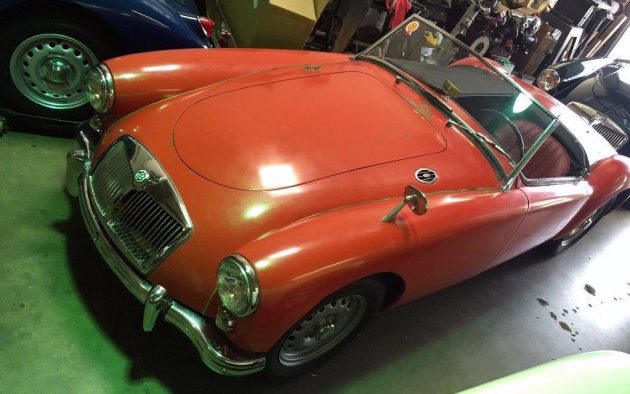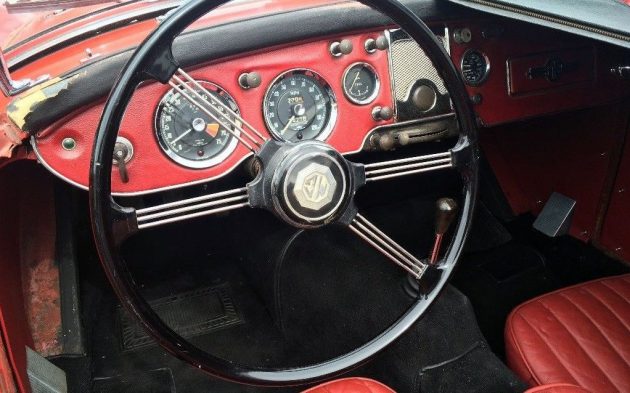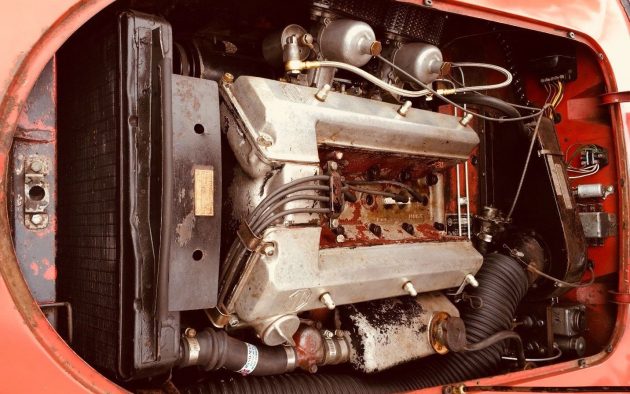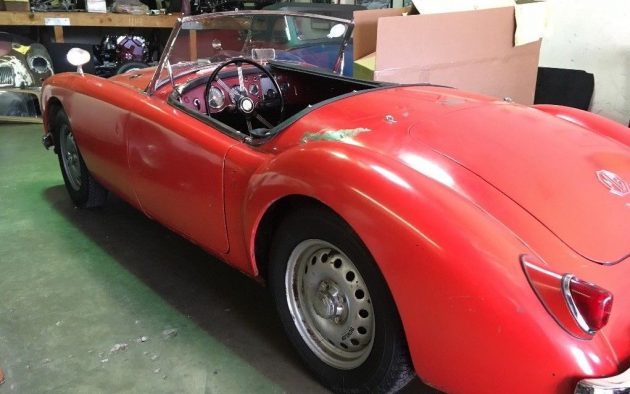This very special sports car has supposedly stashed in a barn since the seventies! It’s not your typical MGA either. It’s a twin-cam equipped roadster and that means it’s rare and worth a pretty penny. The seller has gone through everything and made it roadworthy again. They are planning on getting well-compensated for their efforts though and have listed the car here on eBay for $43,750 or best offer.
This car was put in a barn by a twin-cam enthusiast named James Treat. Perhaps I should know that name, but I don’t. A quick Google search didn’t reveal anything either. Maybe someone here can fill us in on a collector that we should all know about? It’s always nice to know more about a car’s past and its previous owners, so it’s surprising that a dealer wouldn’t give us a little more information to chew on.
The twin-cam received some very nice upgrades over the standard MGA. Obviously, the engine received a dual overhead camshaft in an aluminum head. It also got four-wheel disc brakes and very cool Dunlop knockoff rims that were similar to those fitted to the mighty Jaguar D-Type racers! Engine problems early in production meant that the twin-cam was only offered for two years and very few of these cars are still around today.
The seller states that this is a survivor in the auction listed, but then mentions that it has suffered a poorly done respray. Many people will claim that a car is a survivor and then go on to explain that it has been repainted, reupholstered, and rebuilt. That disqualifies it from “survivor” status in my book, but you can be the judge here. There is no doubt that this is a special little car, but do you think that the condition justifies the asking price?






A good friend bought one for $4K in 1983. We all thought that was a risky putchase at that time. It ran good and just needed cosmetics to be perfect. Are you out there Harold G…?
@Jesse. I don’t think the engine was the problem. The problem was that it needed at least 100 octane fuel which, at the time was unavailable everywhere, so the one that my friend owned was run on Avgas as he worked for Central African Airways and had access to 100 octane and had no engine problems.
I love the idea of having to own an airline in order to make the British sports car go. Central African Airways. And people make fun of my Fiats ;)
The problem with the Twin Cam was that the fuel started to foam in the rear carburetor due to resonance vibrations (at around 3200-5400 RPM), causing a series of engine damages (mostly pistons #3 or #4 burned out).
However, since MG did not recognize the problem with the rear carburetor, they tried to change the ignition timing and reduced the compression, but were unsuccessful and stopped production.
Only after production was stopped, owners found out what caused the problems (racers who had installed Weber instead of the HS6 carburettor had no problems). By then, however, the reputation of the Twin Cam was so ruined that MG no longer started production.
But I don’t see a steering wheel lock, that would have to be installed when the car was delivered to Germany (this was obligatory for new cars from 1955).
Eric Z got the explanation right. These were significantly faster than the regular ’59 MGA 1500 with 72 HP. I know because back when they were close to new I owned a regular 72 HP ‘A’ and raced against a Twin Cam and found out that the TC had a serious edge.
I never found out whether that Twin Cam survived. I hope so because they were rare (2111 made) compared to the regular 1500 (58,750 made).
The median price paid at auction recently for good ones has been about $50K. Looking at the pics of this car tells me that the asking might be high since the car looks like it needs some work, especially what might be some light body work and then a repaint.
But the seller seems to be into MGs and has done some work on this car, so it could be a good car to take the rest of the way. And the color is right. Mine was red, and I can think of no better color for these MGs than red. I hope it goes to a good buyer who will do the right thing by it. These TCs are scarce now, and don’t come up for sale often.
Why do those “knock-offs” have lugnuts?
Dave brings up an interesting note. The wheels, made by Dunlop, were done by welding in a “wire wheel” spline center section to a solid wheel…giving you the best of both worlds…no wires to worry about and the quick change capability of the knock off hubs. The 4 “lug nuts” are merely a left over from when the wheel would have been used differently…they go nowhere and hold nothing…are simply decorative in nature…or they were just too lazy to remove and weld over when they made them…take your pick. Why they would have used a different lug design on a car being sent to Germany makes no sense to me.
However, what is interesting is that the wheels have non standard knockoffs…the ones that are always seen in both the US and UK have 2 ears, for use with a hammer…on this car they are earless and larger, which would require some sort of wrench to take off and tighten. And while these might very well be Dunlop wheels….or wheels made under license to Dunlop, the lug nuts are different from those standard with UK and US sold cars…plus, I’ve never seen that Dunlop decal logo on a car here in the states or overseas with original wheels…only have seen them on repro wheels. That said, the MG factory did make and provide octagonal knockoff hubs (without ears) specifically for the German and Swiss market starting in 1958 with chassis 57500 and these, unlike the standard eared models, were made without any MG logo. It is possible that they welded in a different center section on wheels needing these earless knockoffs, though I haven’t a clue why that might be.
The Twin Cam badge on the rear deck is correct, but the car is missing those Twin Cam badges that should be next to the shroud vents along side the bonnet and there are no holes there to indicate there were any there…it would have come from the factory with them, so that’s strange. Perhaps these were lost along the way and the cheapo paint job covers them…
Lastly, the Twin Cam vin numbers are different from those used by other MGAs. In a TC, the first letter is always Y…the second would be either D (for roadster) or M (for coupe). These two letters would be followed by a number indicating what market it was being built for. Germany, a left hand driving country (as is the US) would have been given a 3…so first three digits for this car would have been YD3…and then the number of the car depending on when it left the factory. This is correct on the ebay description, so if he has some paperwork to show the movement of this car, then it’s likely a real car.
I know people who have owned real Twin Cams, but put standard pushrod motors in them rather than rebuild the Twin Cam that came with it…a lot of original TC cars have these now…but it would be a rare person who would put a TC engine in an original pushrod powered MG to create a Twin Cam.
Eric makes the comment that there should be a steering wheel lock on cars sold in Germany and likely this would have been a dealer installed device as they were not made with these from the factory.
Still, it would be important when buying a car of this value to cross all the t’s and dot all the i’s.
Worth every penny, if not more, found the same looking one 16 years ago in Switzerland, paid $20k.
2111 made, I bet less than 500 around the world exist in running condition.
As the seller and owner/ restorer of 50/60 MGA twin cam cars during the past 40 years, you could say I am biased in my enthusiasm for the cars.
The twin cams have provided spirited travel around Europe/ US and Britain. This example is obviously not restored and it’s value rests in the unmolested original experience of the 1959 sports car driven to CARS AND COFFEE in the California countryside yesterday morning.
Cheers Jim
@Jesse…
. your comment is right on… you make it a clear standard, as it should be.
……….
.
” Many people will claim that a car is a survivor and then go on to explain that it has been repainted, reupholstered, and rebuilt. That disqualifies it from “survivor” status in my book ” ( mine , and most appraisers, too)
but the description doesn’t claim that… James’ only use is in the ad lead line, which is mostly for searches.
This seller knows what he is dealing with, has a good reputation, and I think James has fairly presented a pretty good authentic find.
A friend of mine restored one many years ago and before installing the engine he realised that the distributor was placed in an almost impossible position to be able to set, or renew, the points once the engine was installed. His answer was to cut a hole in the inside fender so that he could gain easy access once the wheel was removed. He then made a cover for the hole so that it looked like it could have been a factory fitting, however, the Concours judges could find NOTHING wrong with the car other than that and demoted the award from a 99% Gold Medal to an 89% Silver Medal. He never restored another car until the day he died!